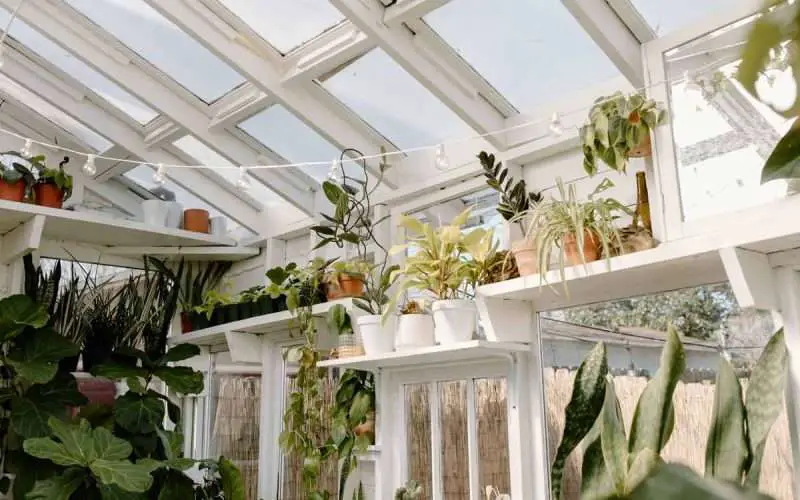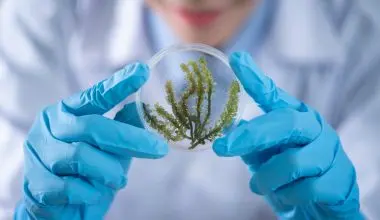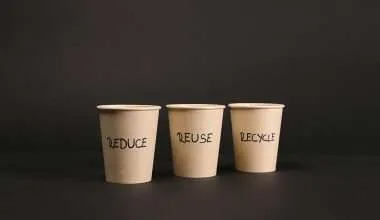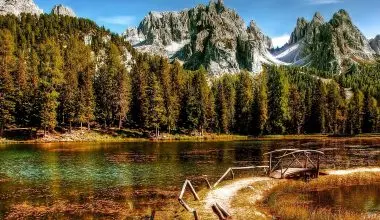Table of Contents Show
What is a Greenhouse?
A greenhouse is a structure which has transparent walls and a roof allowing sunlight to enter the enclosure. Plants are grown inside a greenhouse under a controlled condition.
Greenhouse traps heat and light from the sun, creating a warm and humid environment that is ideal for the growth of plant. It is also known as winter gardening.
You can build your greenhouse with glass, metal, or even plastic. There are a lot of accessories which can be added to your greenhouse in order to enhance its ambiance and to get the job done well. These accessories include sun lamps, heating pads, air circulation system, and water misters.
A greenhouse is an important part of winter gardening. With a greenhouse, you are able to plant and grow your desired fruits, flowers vegetables and other plants without having to worry about the weather. But, you have to do preparations for your winter greenhouse.
Preparing Your Greenhouse
1. Wash the Greenhouse from Inside
Washing your greenhouse from the inside is the first step that should be taken. A bucket of warm water with soap, and a scrubbing brush for the walls and windows is what you need for washing the greenhouse.
If you wish you disinfect the inside thoroughly, you can add bleach of hydrogen peroxide to the warm, soapy water. The water will become a powerful agent and will cleanse the greenhouse extremely well.
However, hydrogen peroxide is a better option than bleach. This is because bleach can cause issues with the roots of plants if they come in contact with it. If bleach has touched any surface and then a plant is placed there, it will have a negative impact on it. Provided that all of the bleach residue is not removed.
Whereas, hydrogen peroxide is not harmful to the plants and is usually safe to be used around them. Also, anything put in excess is not good. Hence, there should be a proper and measured mixture made with only 10% of addition of bleach or hydrogen peroxide.
While cleaning the greenhouse, ensure that the windows are open and the greenhouse is ventilating. This is essential for the escape of all the trapped heat and fumes inside. Plus, it is also important for your health and safety.
Moreover, if your greenhouse is made out of plastic, use a sponge to scrub and clean it. Then use a spray so that the greenhouse is disinfected. And if there are any pest eggs inside, it will help in killing them.
Once you have properly scrubbed the inside of your greenhouse, you should close it for some hours. Make sure that the temperature is normal so there is no risk of combustion. It is best to keep the temperature under 100 degrees F.
2. Repair any Damage
After washing and cleaning your greenhouse, the next step is to check for any damages and work on repairing them. It is a possibility that something could have been damaged while you were cleaning. Or any damage that has been done earlier but could not be fixed due to the presence of plants inside.
Take help of your tools, caulk gun, and the special greenhouse plastic repair tape. When using the caulk gun, remember to take out old caulking. Clean the surface for any dirt or caulk residue. Once everything is clean, run a strip of caulk around the edge of the window to seal it.
Remember that caulk is only useful when the temperature of the air is over 45 degrees. It makes applying easy as well as it will set properly. Therefore, summer is the right season in which one should do caulking.
When working on repairing the damages, add a layer of bubble plastic in your greenhouse. It will help the greenhouse insulate in the months of winter season. This extra layer of bubble plastic will make sure that the greenhouse retains more heat and keeps warm.
Polycarbonate panels are a more permanent choice that can be affixed to the sides and top of the greenhouse. Additionally, foam insulation can be used to cover any gaps or cracks in the walls or the roof.
It is always helpful to ensure that the foundation is solid and does not allow cold winter air to seep in. You should also inspect the doorways and windows to ensure that they are securely sealed and that no draughts are coming in.
3. To Heat or Not to Heat
Heating your greenhouse is your own choice. This is because artificially heating your greenhouse will cost you. It is your decision if you want to incur the cost of a heated greenhouse or you wish to defer it.
One way of heating up your greenhouse with no extra cost is through situating the greenhouse at a place where it can receive maximum light.
Moreover, insulating the north side of the greenhouse will aid in retaining more heat. It acts as a natural greenhouse heater. This is also called the cold wall. In northern regions, this side of the greenhouse receives the least amount of light and is most prone to heat loss.
Furthermore, ensure that you use a waterproof insulating system or you can always go for the one that is especially designed for greenhouse use.
In case, your choice of plants requires higher temperatures, you may need to use electric or gas heaters but then it is necessary to follow safety precautions. It is also better to have a backup plan in case of loss of power such as a generator or a propane heater.
The optimal temperature range for most of the plant species is between 68 to 78 °F.
4. Shade Cloth
Shade cloths are usually used throughout the year when the weather is warmer. But, most regions have the cloth removed by the end of September in order to prepare for the winter months. By this time of the year, you should also put the potted plants and other tender plants inside your greenhouse.
When the winter season begins and the temperature starts to fall below 50 degrees F, you should keep all the plants inside the greenhouse and start to heat it. If you are using a controlled heating method, you have to be vigilant and keep check on the temperature outside as well as inside.
5. Natural Heating Options
A way of trapping heat inside the greenhouse is to arrange 50-55 gallon rain barrels filled with water. This is a proper heating system which works best in a cold temperature. The water has much more capacity to store heat as compared to either concrete or soil.
By using this method we store solar energy in a thermal mass also known as heat sink. This works by absorbing thermal energy during the day and releasing it at night when the temperature is cooler. Moreover, painting the barrels black will help in heat absorption.
However, these drums will take up a lot of space in the greenhouse and that will have to be planned for in the layout of the structure.
Another way for heating is to use solar water heaters. They are not as good an option as they make least amount of heat when it is needed. This is because the sunlight is only available for daylight hours so the solar heaters lose their utility after sunset. Even so, the heating generated during the day can be used to store energy in water as thermal mass and this will help.
Moreover, if the inside temperature goes a little below 50 degrees for a short span of time, it will not cause any major damage to the plants. They should not be in wet soil or else they will be damaged.
6. Insect Control
As winter arrives, you can fumigate your greenhouse with smoke pellets. If you notice any signs of pests in your plants or if you are someone who agrees with an organic approach, you can release beneficial insects in your winter garden.
If you go for fumigation, you will have to wash and clean the windows again.
7. Ventilating your Greenhouse
Although you have to keep your greenhouse warm during the winter months, there is also need to allow for adequate ventilation. Poor ventilation can lead to high humidity levels, which can promote the growth of mold and mildew.
Ventilation can be done by having properly located vents or louvres which depend upon natural air movements. Alternatively fans can be used to circulate the air. Additionally, you would do well to have humidity measuring instruments in your greenhouse.
For healthy plant growth, you can keep the greenhouse relative humidity between 65 to 75 percent at night and 80 to 90 percent during the day.
8. Moving Plants Inside
The time to move your plants from outside to inside the greenhouse and protect them from the cold climate is before the first frost arrives in your area. These should preferably be brought indoors before nighttime temperatures fall below 45°F (7°C).
And this is also the time to take a closer look at your plants and investigate them. If there are any plants that need to be discarded for any reason, you may do so now.
Also, you should also take cuttings of any perennial plants that you wish to replant and take root.
Tips and Tricks for your Greenhouse
Winter season is not a good time to grow plants in. Therefore, people make special winter greenhouses for the survival and growth of their plants. The low light level in the winter season tends to restrict the growth of plants.
For the better growth of the plants, you can add lights which give good results. However, the cost of installing and using these artificial lights is high.
Additionally, if you locate your greenhouse to the south, it will receive a good amount of direct sunlight. Also, going for hardy, resilient plants that can thrive in the winter season will really help you if you are someone who is living in a region that has mostly cold weather.
Moreover, if you are someone who is using an unheated greenhouse, you can try trapping the heat inside with plastic for your greenhouse insulation. This is done by lining the inside of the greenhouse with a layer of bubble plastic. This will retain more heat inside the greenhouse and raise the chances of survival for your weaker plants.
You can also line the inside of the vents with straw or hay matting. It will be useful in cutting drafts down. Make sure to check the vents in order to confirm that they are functional. It is advised to open the vents daily.
Plants usually require less water during winters so adjust the water schedule accordingly . Avoid overwatering your plants, as this can cause root decay. You should also cut back on fertilizer use during the cold.
To sum up, setting up your greenhouse for winter is important for protecting your plants from severe weather. By following up on the above timely steps, you can be sure that your plants survive the winter and thrive in the spring.






